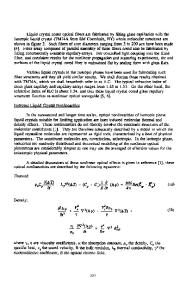Novel Polycarbonate Diacetylene Materials for Optical Limiting
- PDF / 375,765 Bytes
- 6 Pages / 414.72 x 648 pts Page_size
- 24 Downloads / 374 Views
Of several polymeric materials that could be used as a passive binder for a limiter device, the polycarbonate of bis -phenol A("Lexan" or "Makrolon") has been used in many existing commercial products that afford protection at single wavelengths because of its attractive thermal, mechanical, and ballistic properties. In this report, we summarize our progress in combining the attractive properties of PDA for optical limiting with several polycarbonates. In particular we describe studies of composites of the polycarbonate of bis -phenol A with the PDA from 1,6-di-N-carbazolyl-2,4-hexadiyne(DCH), and of macromonomeric materials combining diacetylene(DA) groups with bis -phenol carbonate groups. The latter substances are expected to crosspolymerize to useful PDA structures. Among several classes of conjugated polymers 3 that have been investigated for third order nonlinear optical(NLO) properties, PDAs, including PDA-DCH, are the most attractive from the perspective of their linear spectra covering most of the visible region, the magnitude and temporal response of the third order NLO coefficient, X( 3 ), in both transparent and absorbing regions4 , and the degree of definition of the resulting polymers. For applications in optical limiting, PDA are attractive because of their linear absorption in the visible and their light intensity(I) dependent refractive index, n2, in equation 1, n = no + n2E
and n2 is related to X(3)5 (equation 2):
73 Mat. Res. Soc. Symp. Proc. Vol. 374 01995 Materials Research Society
(1)
n2 =
16ir,2_X(3)
(2)
CEI The value of n2 in PDA, 1.5 x 10-12 cm 2 /W, is larger than that observed in III-V 6 semiconductors. POLYCARBONATE-PDA-DCH COMPOSITES Since the mechanical and ballistic materials of the polycarbonate of bis -phenol A make it the binder material of choice for optical limiting applications such as eye protection, especially in devices intended to function at single wavelengths, it is of interest to learn if materials such as PDA are compatible with polycarbonate. If compatible, then technology based on PDA is relevant for further development. The DA chosen for this study is DCH because it is readily available, it may be thermally polymerized, it absorbs across the visible, and the presence of the carbazole provides a signature that is readily detected by electronic spectroscopy. This section reports the fabrication of polycarbonate-PDA-DCH composites and their characterization by electronic spectroscopy, scanning electron microscopy(SEM), and laser power transmission. Scheme 1 shows the relevant molecular structures. R
ICCCC
R=
Q7Jy
R
DCH
H2_
PDA, en-yne
C(CH
O-(CO)-O; n
Scheme 1. Molecular structures of PDA-DCH and polycarbonate of bis -phenol A. Earlier, composites of PDA-DCH fibers were prepared by polymerization of monomer by gamma radiation, and dispersion of the fibers in an epoxy matrix. 7 Other 8 reports of composites of PDA with other polymers were recently summarized. 9 DCH monomer was synthesized as previously described. The polycarbonate was obtained from Aldri
Data Loading...











